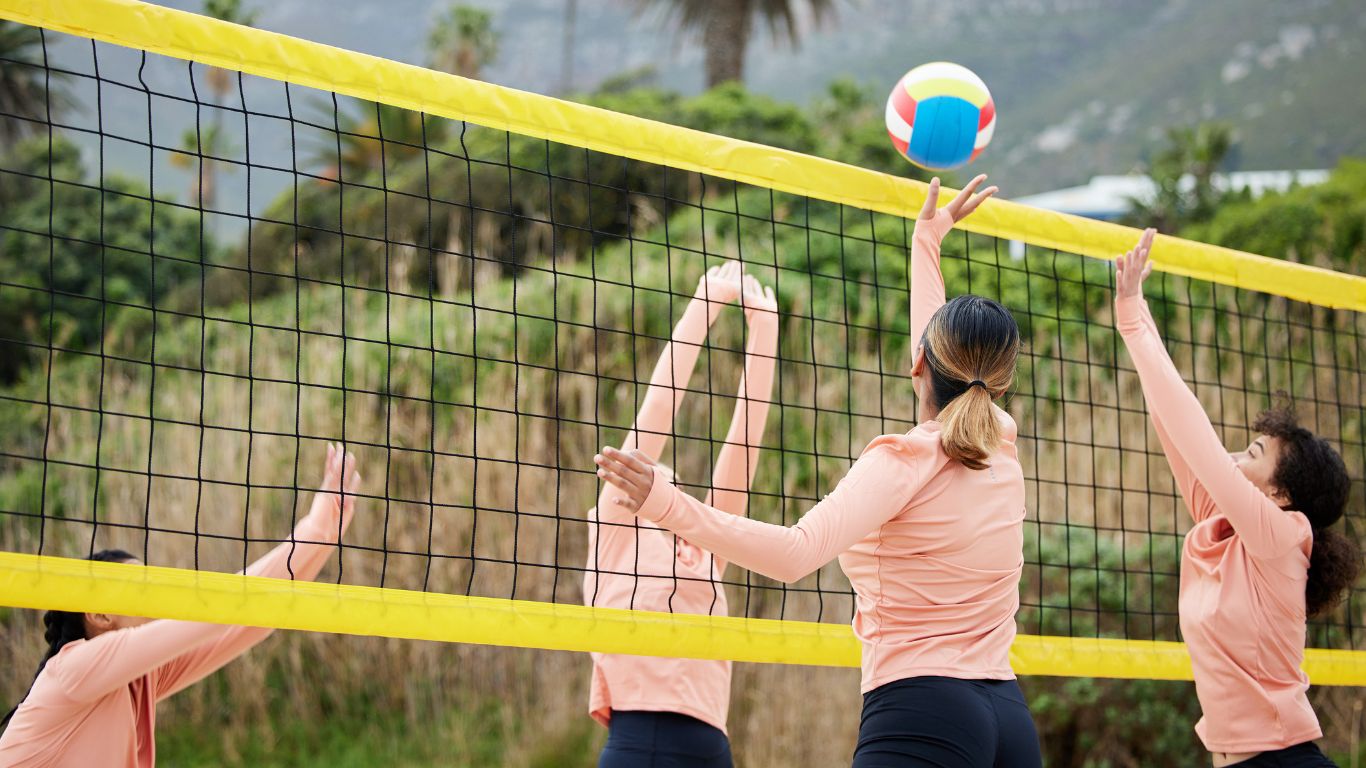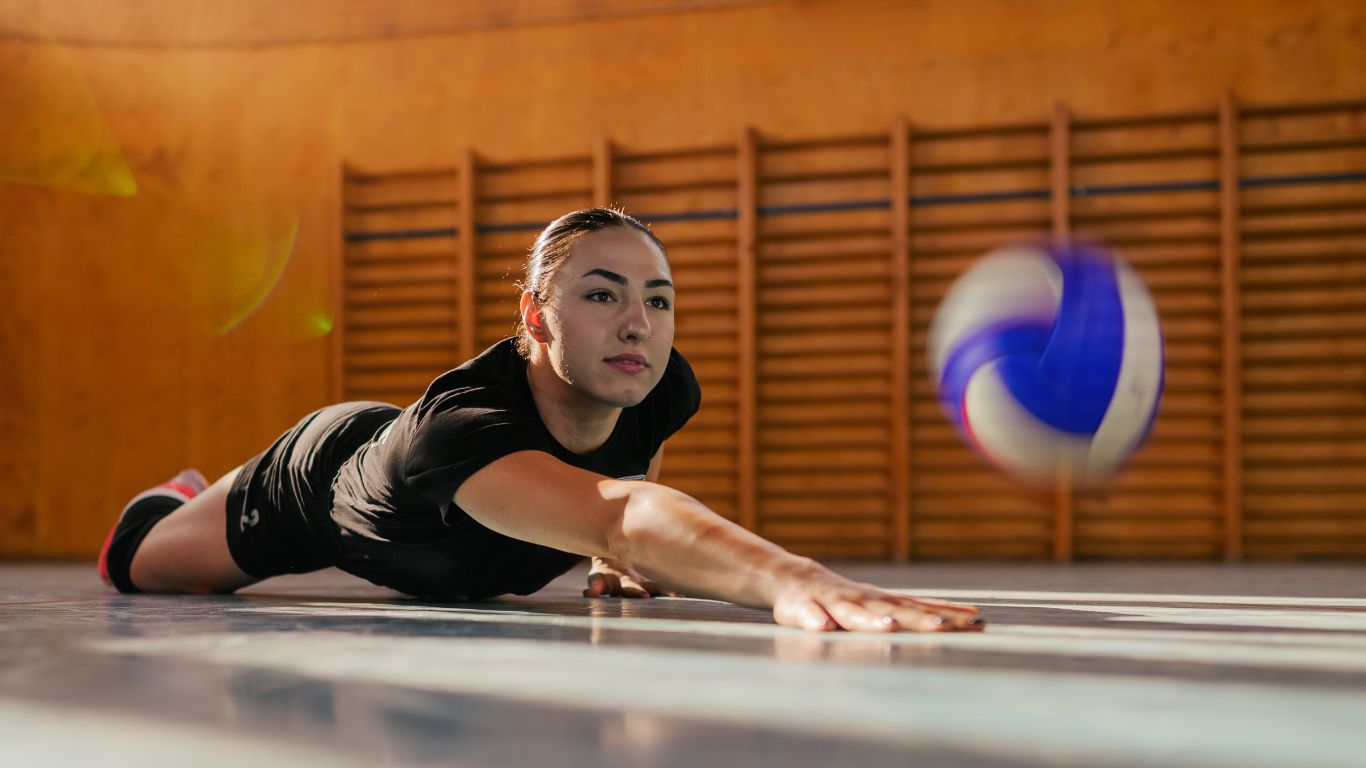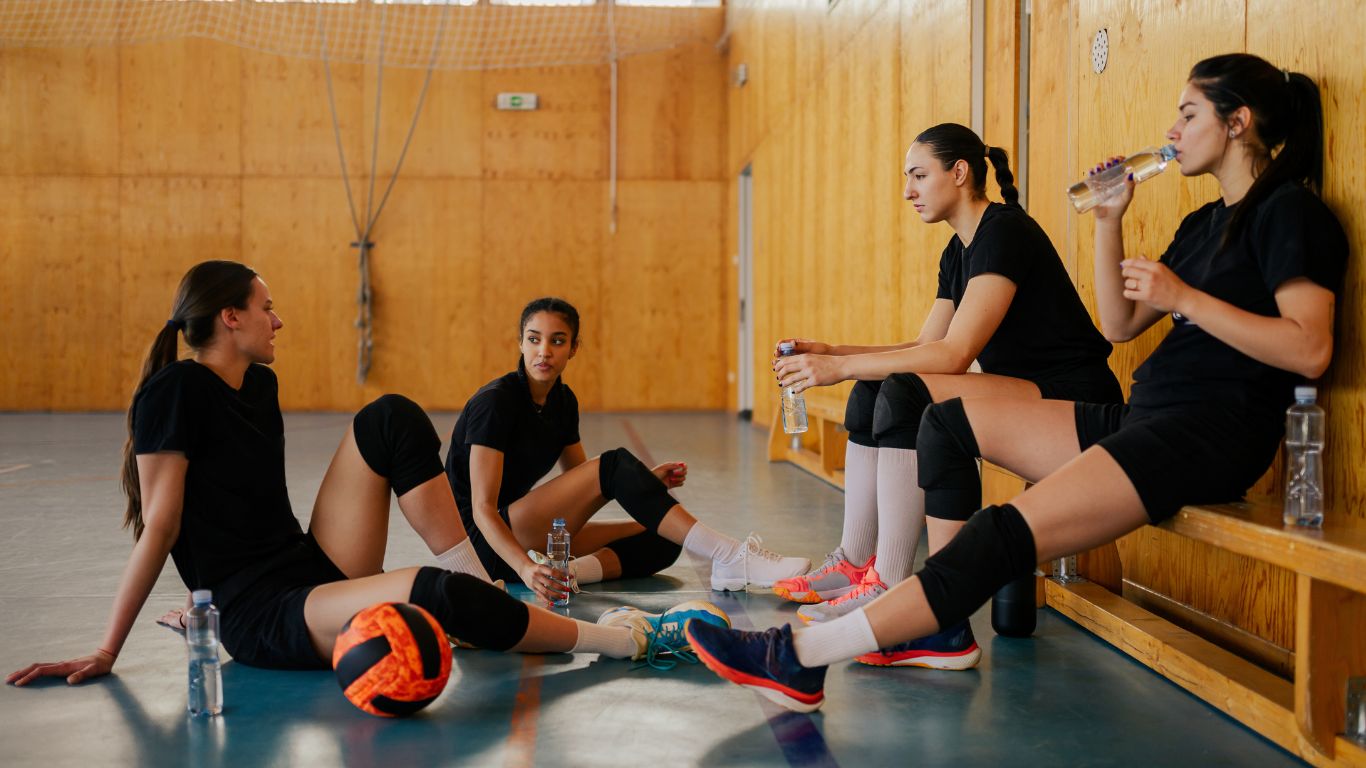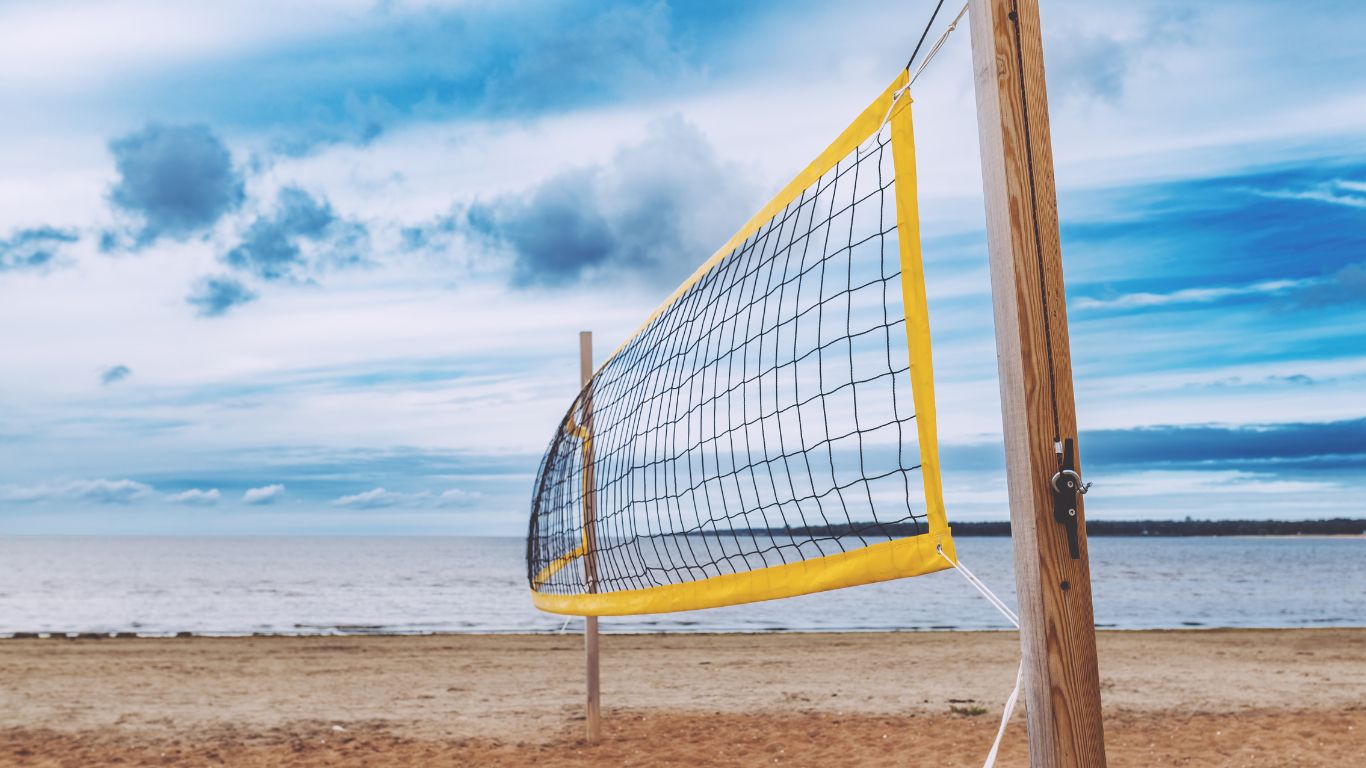A dig in volleyball is when a player passes or retrieves the ball after it has been hit by the opposing team. In volleyball, a dig is a defensive technique used to prevent the ball from touching the ground on your side of the court.
In the fast-paced game of volleyball, players need to be skilled at both offensive and defensive techniques. One such defensive move is the dig. A dig is the act of passing or retrieving the ball after it has been hit by the opposing team.
When the ball is spiked or driven towards your side of the court, your objective is to prevent it from touching the ground by executing a dig. This defensive move requires quick reactions, good footwork, and precise hand placement to effectively control the ball and keep it in play. We will delve deeper into the technique of a dig in volleyball and explore its importance in the game.

Credit: www.dimensions.com
The Basics Of A Dig
A dig in volleyball is a defensive move where a player uses their forearms to control and return a spiked ball. It is an essential skill in the game, requiring quick reflexes and precise technique to successfully keep the ball in play.
Definition
A dig is a fundamental skill in volleyball used to receive an opponent’s attack and keep the ball in play. It is a defensive technique employed when the ball is hit with power and speed towards your team’s side of the court. The goal of a dig is to control the ball and deliver it to a teammate for a successful attack or set. Mastering the technique of a dig is crucial in order to maintain a fast-paced and competitive game.
Technique
The technique of a dig involves a combination of proper positioning, timing, and body control. Here’s a breakdown of the key steps to execute a successful dig:
- Positioning: When anticipating an opponent’s attack, position yourself with your feet shoulder-width apart and your knees slightly bent. This stance allows for quick movement in any direction.
- Anticipation: Watch the hitter’s approach and observe their body language to anticipate the direction and speed of the attack. This allows you to be ready to react and move accordingly.
- Platform: Create a solid platform by overlapping your wrists with your palms facing upwards. This provides a larger surface area for the ball to contact, increasing your chances of a successful dig.
- Contact: As the ball approaches, meet it with your platform slightly above your waist and slightly in front of your body. This allows you to direct the ball towards your intended target.
- Control: Absorb the impact of the ball by flexing your knees and using your legs to control the power of the attack. This helps prevent the ball from rebounding off your platform.
- Direction: Aim to direct the ball to your desired location by angling your platform. If you want a high, controlled pass, angle your platform slightly upwards. For a lower pass closer to the net, angle it slightly downwards.
- Follow-through: After making contact with the ball, extend your arms and follow through in the direction you want the ball to go. This helps maintain accuracy and control.
Practicing these steps and honing your dig technique will greatly enhance your defensive skills on the volleyball court. Remember, consistent practice and game experience are essential in mastering this fundamental skill. So keep working hard, and soon enough, you’ll be executing successful digs with confidence!
Importance Of The Dig
A vital move in volleyball, the dig plays a crucial role in preventing the ball from hitting the ground. It is executed by a player to control the ball after an opponent’s attack. The dig is essential for setting up successful offensive plays and maintaining momentum in the game.
Preventing The Opponent’s Attack
The dig is an essential skill in volleyball that involves a player using their forearms to receive the opponent’s attack. It is a defensive move made to prevent the ball from hitting the ground and keep the rally going. The dig plays a critical role in disrupting the opponent’s offensive play and setting up a counterattack for your team. By effectively executing a dig, players can control the speed and direction of the ball, making it challenging for the opposing team to execute a successful attack.
Setting Up For A Counterattack
Once the ball is successfully dug, it opens up the opportunity for a counterattack. The dig in volleyball acts as the foundation for the next play, enabling the setter to set up the ball for another player to attack. It is the first step in transitioning from defense to offense. A well-executed dig allows the setter to deliver an accurate and precise set to their teammates, giving them the chance to go on the offensive and score points. To ensure an effective dig, players must focus on proper body positioning, using their legs for stability, and maintaining a firm platform with their forearms. By keeping their eye on the ball and anticipating their opponent’s attack, players can react quickly and efficiently to make successful digs. The ability to consistently dig the ball and set up for a counterattack is a valuable skill that can make a significant difference in the outcome of a volleyball match. In summary, the dig in volleyball is of utmost importance as it not only prevents the opponent’s attack by controlling the ball’s trajectory but also sets up the opportunity for a counterattack. By mastering the techniques and fundamentals of the dig, players can contribute significantly to their team’s success on the court.
Mastering The Defensive Art
When it comes to volleyball, mastering the defensive art of the dig is crucial for success on the court. A dig is a defensive move used to prevent the ball from touching the ground after a spike or attack, allowing the team to continue the rally. For players looking to elevate their defensive skills, developing quick reflexes, perfecting body positioning, and improving communication are essential components.
Developing Quick Reflexes
Quick reflexes are vital for a successful dig in volleyball. Players need to react swiftly to the opponent’s attack, anticipating the trajectory of the ball and moving into position to make the dig. To develop quick reflexes, players can engage in drills that simulate game situations, such as reaction drills and rapid-fire digging exercises. These drills help players to build muscle memory and improve their response time, allowing them to react more effectively during matches.
Perfecting Body Positioning
Body positioning plays a key role in mastering the defensive art of the dig. Players must maintain a low and balanced stance, keeping their weight forward and their arms ready to absorb the impact of the ball. By perfecting body positioning, players can increase their chances of making successful digs while minimizing the risk of injury. Coaches can emphasize proper body alignment through hands-on demonstrations, providing feedback to help players refine their posture and technique.
Improving Communication
Effective communication is essential for a cohesive defensive effort in volleyball. Players should communicate with their teammates to avoid overlap and ensure that everyone understands their responsibilities on the court. By improving communication, players can anticipate each other’s movements, cover the court more effectively, and ultimately enhance their defensive performance. Team bonding activities and regular communication drills can help players strengthen their on-court rapport and foster a more unified defensive strategy.

Credit: www.betteratbeach.com
Training Drills For Digs
When it comes to improving your skills in volleyball, training drills for digs are essential. Digs are the defensive moves used to prevent the ball from hitting the ground after a spike or attack, making them a crucial aspect of the game. By practicing specific training drills for digs, players can enhance their defensive capabilities and overall game performance.
Solo Dig Drills
Solo dig drills focus on developing an individual player’s ability to effectively receive and control the ball. These drills help in improving reflexes and agility, which are vital for successful digs. A popular solo dig drill is the repetitive wall dig, where the player continuously hits the ball against the wall while practicing proper digging technique. Another effective drill is the ladder drill, where the player moves laterally along a ladder on the ground, simulating the movement required to reach and dig the ball. Moreover, the cone drill involves placing cones at various distances and angles, requiring the player to quickly react and dig the ball at different positions.
Partner/teammate Dig Drills
Partner or teammate dig drills focus on simulating game situations and improving communication and teamwork. These drills help in developing the ability to anticipate the ball’s trajectory and coordinate with teammates to successfully execute a dig. One popular partner drill is the pepper drill, where two players alternate hitting the ball to each other, focusing on controlled digs and precise ball placement. Moreover, the cross-court dig drill involves one player making attacking shots across the court while the other focuses on defensive digs, simulating game scenarios and enhancing defensive skills.
Common Mistakes To Avoid
Digging in volleyball is a fundamental skill that involves using the forearms to receive a spiked ball. Avoiding common mistakes such as incorrect body positioning, lack of communication, and improper technique will help players improve their dig accuracy and overall defensive abilities.
In order to execute a successful dig in volleyball, it’s important to understand and avoid some common mistakes. By recognizing and addressing these errors, you can improve your defensive skills and contribute to your team’s success on the court.
Swinging Arms Instead Of Platform
One mistake that beginners often make when attempting a dig is swinging their arms instead of utilizing a proper platform. A platform refers to the flat surface formed by bringing your forearms together, creating a solid base for the ball to rebound off. By swinging your arms, you lose control and accuracy, making it difficult to direct the ball to your desired target.
To avoid this mistake, focus on creating a firm and stable platform by locking your wrists and keeping your elbows straight. Remember to position your hands slightly in front of you, with your palms facing the ceiling. This not only provides a larger surface area to contact the ball but also allows for better control and accuracy.
Late/incorrect Footwork
Proper footwork is crucial to successfully execute a dig. One common mistake is having late or incorrect footwork, which can lead to mistimed movements and poor balance. This can result in missed opportunities to make a clean dig or even lead to injury.
To avoid this mistake, focus on your footwork and positioning. Start by maintaining a balanced stance with your feet shoulder-width apart. As the ball approaches, take a small step with your leading foot towards the direction you want to send the ball. Simultaneously, pivot on your back foot to align your body and provide stability. This ensures that you are in the best position to make a controlled dig and accurately direct the ball to your teammates.
In conclusion, by being aware of these common mistakes and consciously working to correct them, you can improve your dig in volleyball. Remember to focus on creating a firm platform with your arms and maintaining proper footwork to maximize your defensive contributions during the game.

Credit: www.airbornevolleyball.com
Frequently Asked Questions On What Is A Dig In Volleyball
What Is Counted As A Dig?
A dig refers to any action where soil or ground is disturbed, such as excavations or creating holes.
Why Do We Dig In Volleyball?
Digging in volleyball is crucial to save the ball from hitting the ground. It’s a defensive move to control the incoming spike or serve. It requires quick reflexes and precise positioning to keep the ball in play.
What Is The Difference Between Digging And Passing In Volleyball?
Digging and passing are both important skills in volleyball. Digging is when a player uses their forearms to receive a spiked ball, while passing is when a player uses their hands to control and direct the ball to a teammate.
Both skills require precise technique and good reflexes.
How Do You Count A Dig In Volleyball?
A dig in volleyball is counted whenever a player successfully receives an attacked ball from the opposing team without it touching the ground.
Conclusion
The dig in volleyball is an essential defensive technique that involves passing the ball close to the ground using the forearm. It requires quick reflexes, precise ball control, and proper body positioning. By mastering the dig, players can effectively receive powerful spikes and keep the ball in play.
Successful digging can turn the tide of a game and contribute to overall team success. Keep practicing to perfect this fundamental skill and elevate your game!









